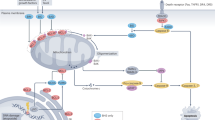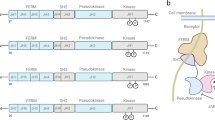Abstract
Lysosome-associated protein transmembrane-4b (LAPTM4B) associates with poor prognosis in several cancers, but its physiological function is not well understood. Here we use novel ceramide probes to provide evidence that LAPTM4B interacts with ceramide and facilitates its removal from late endosomal organelles (LEs). This lowers LE ceramide in parallel with and independent of acid ceramidase–dependent catabolism. In LAPTM4B-silenced cells, LE sphingolipid accumulation is accompanied by lysosomal membrane destabilization. However, these cells resist ceramide-driven caspase-3 activation and apoptosis induced by chemotherapeutic agents or gene silencing. Conversely, LAPTM4B overexpression reduces LE ceramide and stabilizes lysosomes but sensitizes to drug-induced caspase-3 activation. Together, these data uncover a cellular ceramide export route from LEs and identify LAPTM4B as its regulator. By compartmentalizing ceramide, LAPTM4B controls key sphingolipid-mediated cell death mechanisms and emerges as a candidate for sphingolipid-targeting cancer therapies.
This is a preview of subscription content, access via your institution
Access options
Subscribe to this journal
Receive 12 print issues and online access
$259.00 per year
only $21.58 per issue
Buy this article
- Purchase on Springer Link
- Instant access to full article PDF
Prices may be subject to local taxes which are calculated during checkout






Similar content being viewed by others
References
Schulze, H. & Sandhoff, K. Sphingolipids and lysosomal pathologies. Biochim. Biophys. Acta 1841, 799–810 (2014).
Kolter, T. & Sandhoff, K. Lysosomal degradation of membrane lipids. FEBS Lett. 584, 1700–1712 (2010).
Lloyd-Evans, E. et al. Niemann-Pick disease type C1 is a sphingosine storage disease that causes deregulation of lysosomal calcium. Nat. Med. 14, 1247–1255 (2008).
Speak, A.O. et al. Altered distribution and function of natural killer cells in murine and human Niemann-Pick disease type C1. Blood 123, 51–60 (2014).
Blom, T., Li, Z., Bittman, R., Somerharju, P. & Ikonen, E. Tracking sphingosine metabolism and transport in sphingolipidoses: NPC1 deficiency as a test case. Traffic 13, 1234–1243 (2012).
Hanada, K. et al. Molecular machinery for non-vesicular trafficking of ceramide. Nature 426, 803–809 (2003).
Truman, J.-P., García-Barros, M., Obeid, L.M. & Hannun, Y.A. Evolving concepts in cancer therapy through targeting sphingolipid metabolism. Biochim. Biophys. Acta 1841, 1174–1188 (2014).
Park, J.-W., Park, W.-J. & Futerman, A.H. Ceramide synthases as potential targets for therapeutic intervention in human diseases. Biochim. Biophys. Acta 1841, 671–681 (2014).
Henry, B., Möller, C., Dimanche-Boitrel, M.-T., Gulbins, E. & Becker, K.A. Targeting the ceramide system in cancer. Cancer Lett. 332, 286–294 (2013).
Ogretmen, B. & Hannun, Y.A. Biologically active sphingolipids in cancer pathogenesis and treatment. Nat. Rev. Cancer 4, 604–616 (2004).
Morad, S.A.F. & Cabot, M.C. Ceramide-orchestrated signalling in cancer cells. Nat. Rev. Cancer 13, 51–65 (2013).
Kallunki, T., Olsen, O.D. & Jäättelä, M. Cancer-associated lysosomal changes: friends or foes? Oncogene 32, 1995–2004 (2013).
Kirkegaard, T. et al. Hsp70 stabilizes lysosomes and reverts Niemann-Pick disease-associated lysosomal pathology. Nature 463, 549–553 (2010).
Petersen, N.H.T. et al. Transformation-associated changes in sphingolipid metabolism sensitize cells to lysosomal cell death induced by inhibitors of acid sphingomyelinase. Cancer Cell 24, 379–393 (2013).
Aits, S. & Jäättelä, M. Lysosomal cell death at a glance. J. Cell Sci. 126, 1905–1912 (2013).
Ellegaard, A.-M. et al. Sunitinib and SU11652 inhibit acid sphingomyelinase, destabilize lysosomes, and inhibit multidrug resistance. Mol. Cancer Ther. 12, 2018–2030 (2013).
Chipuk, J.E. et al. Sphingolipid metabolism cooperates with BAK and BAX to promote the mitochondrial pathway of apoptosis. Cell 148, 988–1000 (2012).
Tafesse, F.G. et al. Sphingomyelin synthase-related protein SMSr is a suppressor of ceramide-induced mitochondrial apoptosis. J. Cell Sci. 127, 445–454 (2014).
Lee, H. et al. Mitochondrial ceramide-rich macrodomains functionalize Bax upon irradiation. PLoS ONE 6, e19783 (2011).
Swanton, C. et al. Regulators of mitotic arrest and ceramide metabolism are determinants of sensitivity to paclitaxel and other chemotherapeutic drugs. Cancer Cell 11, 498–512 (2007).
Li, Y. et al. Lysosomal transmembrane protein LAPTM4B promotes autophagy and tolerance to metabolic stress in cancer cells. Cancer Res. 71, 7481–7489 (2011).
Yang, H. et al. Overexpression of LAPTM4B–35 promotes growth and metastasis of hepatocellular carcinoma in vitro and in vivo. Cancer Lett. 294, 236–244 (2010).
Li, Y. et al. Amplification of LAPTM4B and YWHAZ contributes to chemotherapy resistance and recurrence of breast cancer. Nat. Med. 16, 214–218 (2010).
Shao, G.-Z. et al. Molecular cloning and characterization of LAPTM4B, a novel gene upregulated in hepatocellular carcinoma. Oncogene 22, 5060–5069 (2003).
De Ronde, J.J. et al. SERPINA6, BEX1, AGTR1, SLC26A3, and LAPTM4B are markers of resistance to neoadjuvant chemotherapy in HER2-negative breast cancer. Breast Cancer Res. Treat. 137, 213–223 (2013).
Hogue, D.L., Ellison, M.J., Young, J.D. & Cass, C.E. Identification of a novel membrane transporter associated with intracellular membranes by phenotypic complementation in the yeast Saccharomyces cerevisiae. J. Biol. Chem. 271, 9801–9808 (1996).
Hogue, D.L., Kerby, L. & Ling, V. A mammalian lysosomal membrane protein confers multidrug resistance upon expression in Saccharomyces cerevisiae. J. Biol. Chem. 274, 12877–12882 (1999).
Cabrita, M.A., Hobman, T.C., Hogue, D.L., King, K.M. & Cass, C.E. Mouse transporter protein, a membrane protein that regulates cellular multidrug resistance, is localized to lysosomes. Cancer Res. 59, 4890–4897 (1999).
Li, L. et al. LAPTM4B: a novel cancer-associated gene motivates multidrug resistance through efflux and activating PI3K/AKT signaling. Oncogene 29, 5785–5795 (2010).
Tan, X. et al. LAPTM4B is a PtdIns(4,5)P2 effector that regulates EGFR signaling, lysosomal sorting, and degradation. EMBO J. 34, 475–490 (2015).
Tan, X., Thapa, N., Sun, Y. & Anderson, R.A.A. Kinase-Independent Role for EGF Receptor in Autophagy Initiation. Cell 160, 145–160 (2015).
Vergarajauregui, S., Martina, J.A. & Puertollano, R. LAPTMs regulate lysosomal function and interact with mucolipin 1: new clues for understanding mucolipidosis type IV. J. Cell Sci. 124, 459–468 (2011).
Pietiäinen, V. et al. NDRG1 functions in LDL receptor trafficking by regulating endosomal recycling and degradation. J. Cell Sci. 126, 3961–3971 (2013).
Shen, D. et al. Lipid storage disorders block lysosomal trafficking by inhibiting a TRP channel and lysosomal calcium release. Nat. Commun. 3, 731 (2012).
Wegner, C.S. et al. Ultrastructural characterization of giant endosomes induced by GTPase-deficient Rab5. Histochem. Cell Biol. 133, 41–55 (2010).
Reynolds, C.P., Maurer, B.J. & Kolesnick, R.N. Ceramide synthesis and metabolism as a target for cancer therapy. Cancer Lett. 206, 169–180 (2004).
Ji, C. et al. Exogenous cell-permeable C6 ceramide sensitizes multiple cancer cell lines to Doxorubicin-induced apoptosis by promoting AMPK activation and mTORC1 inhibition. Oncogene 29, 6557–6568 (2010).
Bedia, C., Casas, J., Andrieu-Abadie, N., Fabriàs, G. & Levade, T. Acid ceramidase expression modulates the sensitivity of A375 melanoma cells to dacarbazine. J. Biol. Chem. 286, 28200–28209 (2011).
Ullio, C. et al. Sphingosine mediates TNFα-induced lysosomal membrane permeabilization and ensuing programmed cell death in hepatoma cells. J. Lipid Res. 53, 1134–1143 (2012).
Heinrich, M. et al. Cathepsin D links TNF-induced acid sphingomyelinase to Bid-mediated caspase-9 and -3 activation. Cell Death Differ. 11, 550–563 (2004).
Heinrich, M. et al. Cathepsin D targeted by acid sphingomyelinase-derived ceramide. EMBO J. 18, 5252–5263 (1999).
Ostenfeld, M.S. et al. Effective tumor cell death by sigma-2 receptor ligand siramesine involves lysosomal leakage and oxidative stress. Cancer Res. 65, 8975–8983 (2005).
Sandhoff, K. My journey into the world of sphingolipids and sphingolipidoses. Proc. Jpn. Acad., Ser. B, Phys. Biol. Sci. 88, 554–582 (2012).
Trajkovic, K. et al. Ceramide triggers budding of exosome vesicles into multivesicular endosomes. Science 319, 1244–1247 (2008).
Contreras, F.-X. et al. Molecular recognition of a single sphingolipid species by a protein’s transmembrane domain. Nature 481, 525–529 (2012).
Björkholm, P. et al. Identification of novel sphingolipid-binding motifs in mammalian membrane proteins. Biochim. Biophys. Acta 1838, 2066–2070 (2014).
Juul, N. et al. Assessment of an RNA interference screen-derived mitotic and ceramide pathway metagene as a predictor of response to neoadjuvant paclitaxel for primary triple-negative breast cancer: a retrospective analysis of five clinical trials. Lancet Oncol. 11, 358–365 (2010).
Lee, A.J.X. et al. CERT depletion predicts chemotherapy benefit and mediates cytotoxic and polyploid-specific cancer cell death through autophagy induction. J. Pathol. 226, 482–494 (2012).
Bandhuvula, P., Li, Z., Bittman, R. & Saba, J.D. Sphingosine 1-phosphate lyase enzyme assay using a BODIPY-labeled substrate. Biochem. Biophys. Res. Commun. 380, 366–370 (2009).
Loizides-Mangold, U., David, F.P.A., Nesatyy, V.J., Kinoshita, T. & Riezman, H. Glycosylphosphatidylinositol anchors regulate glycosphingolipid levels. J. Lipid Res. 53, 1522–1534 (2012).
Sullards, M.C. & Merrill, A.H. Analysis of sphingosine 1-phosphate, ceramides, and other bioactive sphingolipids by high-performance liquid chromatography-tandem mass spectrometry. Sci. STKE 2001, pl1 (2001).
Acknowledgements
The authors thank K. Sandhoff for helpful comments on the manuscript; A. Uro and D.J. Baek for technical support; S. Hautaniemi, R. Louhimo and S. Karinen for help with bioinformatics and the Biomedicum imaging unit for help with microscopy. This study was supported by Academy of Finland grants 273533 and 266092 (T.B.), 131489, 263841 and 272130 (E.I.), the Liv och Hälsa Foundation (T.B. and N.B.), the University of Helsinki Research Fund Grant (T.B.), the Ruth and Nils-Erik Stenbäck Foundation (T.B.), the Finnish Medical Foundation (E.I. and R.B.), the Sigrid Juselius Foundation (E.I.), the Magnus Ehrnrooth Foundation (N.B.), the Perklén Foundation (N.B.), the Swiss National Science Foundation (H.R.), the NCCR Chemical Biology (H.R.) and SystemsX.ch (H.R.).
Author information
Authors and Affiliations
Contributions
E.I. and T.B. conceived the project, designed and analysed experiments. T.B., S.L. and A.D. designed, carried out and analyzed experiments. N.B. carried out and analysed the electron microscopy experiments. R.B. conceived and designed the synthesis of the fluorescent ceramide probes, and Y.A.K. carried out the synthesis. H.R. planned and U.L.-M. carried out the lipid mass spectrometry and analysed the data. E.I. and T.B. wrote the manuscript; all authors read and commented on it.
Corresponding authors
Ethics declarations
Competing interests
The authors declare no competing financial interests.
Supplementary information
Supplementary Text and Figures
Supplementary Figures 1–23, Supplementary Tables 1 and 2 and Supplementary Note (PDF 2772 kb)
Movement of LAPTM4B-Cherry and ceramide-BODIPY positive organelles along the ER
Stable A431 cells overexpressing LAPTM4B-Cherry were transfected with BFP-KDEL cDNA to label the ER. Starting at 24 h post-transfection, the cells were serum starved for 16 h. Cells were then pulsed with ceramide-BODIPY/LDL for 1 h, chased for 30 min in serum free medium and imaged by confocal microscopy. The image capture rate was ~0.4fps. See also Supplementary Figure 18. (MOV 10127 kb)
Rights and permissions
About this article
Cite this article
Blom, T., Li, S., Dichlberger, A. et al. LAPTM4B facilitates late endosomal ceramide export to control cell death pathways. Nat Chem Biol 11, 799–806 (2015). https://doi.org/10.1038/nchembio.1889
Received:
Accepted:
Published:
Issue Date:
DOI: https://doi.org/10.1038/nchembio.1889
This article is cited by
-
miR-137–LAPTM4B regulates cytoskeleton organization and cancer metastasis via the RhoA-LIMK-Cofilin pathway in osteosarcoma
Oncogenesis (2023)
-
A newly anticipated role for Laptm4b in retinal outer segment development
Eye (2022)
-
Lysosomal integral membrane protein-2 (LIMP-2/SCARB2) is involved in lysosomal cholesterol export
Nature Communications (2019)
-
Plant sphingolipids promote extracellular vesicle release and alleviate amyloid-β pathologies in a mouse model of Alzheimer’s disease
Scientific Reports (2019)
-
Sphingolipid metabolism in cancer signalling and therapy
Nature Reviews Cancer (2018)



